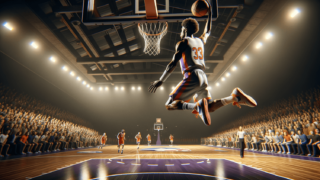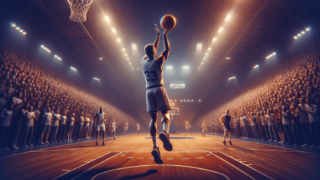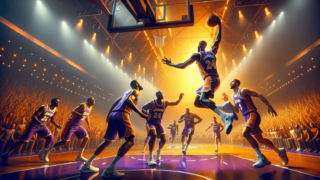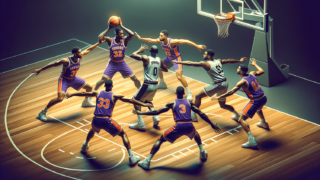
Basketball Dead Ball Rule: When Play Stops
Written by: Basketball Universe
Last updated:

Welcome to the exciting world of basketball, where action on the court is fast-paced and exhilarating! However, amidst the high-flying dunks and game-winning shots, it’s important to understand the intricacies of the game, including one of the most fundamental rules: the dead ball rule. In this informative and entertaining blog post, we will dive deep into the various scenarios that trigger a dead ball and examine the effects these stoppages have on gameplay. Whether you’re an avid fan or just starting to appreciate the beauty of basketball, this comprehensive guide is sure to enhance your knowledge of when the ball goes, quite literally, out of play!
Basketball Dead Ball Rule: When Play Stops
The basketball dead ball rule refers to the moments during a game when the ball becomes dead and play stops. This usually occurs when a violation, foul, or timeout is called, when the ball goes out of bounds, or after a successful field goal or free throw. During a dead ball situation, players must wait for the referee’s whistle to resume play, ensuring order and fair competition on the court.
Understanding the Basketball Dead Ball Rule
Before delving into the nitty-gritty of the dead ball rule, it’s crucial to understand the difference between a live ball and a dead ball in basketball. The live ball is when the game is actively in progress, and the players can maneuver, pass, and shoot to score points. A dead ball situation disrupts the flow of the game, bringing it to a temporary halt for various reasons. In this blog post, we will not only explore what factors cause the ball to become dead, but also discuss how and when the game resumes.
Causes of a Dead Ball in Basketball
Several game events can lead to a dead ball situation. Stoppages in play help maintain control over the game and guarantee that players follow the basketball rules consistently. Let’s review the main causes of a dead ball.
Violations and Out of Bounds
A violation occurs when a player breaks one of the game’s established rules, such as traveling, double dribbling, or committing a backcourt violation. These errors all result in a turnover, meaning the opposing team will gain possession of the ball. Similarly, when the ball or player touches the boundary line or goes out of bounds, play will also stop, and the ball will be awarded to the other team. In both cases, the ball is considered dead as soon as the whistle blows or the referee signals the violation.
Personal and Technical Fouls
Personal fouls, which usually involve physical contact between the players, can also lead to a dead ball situation. Some common examples are illegal hand checking, blocking, or charging. Play typically stops when the whistle is blown, and the game action is briefly paused. If the player is in the act of shooting during a foul, they may be awarded free throws, depending on whether the shot is successful or unsuccessful.
Technical fouls, on the other hand, are non-contact violations that can be called on a player, coach, or even the team itself. Examples include delay of game, unsportsmanlike conduct, or arguing with the referees. Once the technical foul is called, the ball is considered dead, and the other team is usually granted free throws, along with possession of the ball.
Scored Baskets and Free Throws
Another common scenario where the ball becomes dead is after a successful field goal or free throw. Once the ball passes through the hoop and touches the floor or a player, the ball is dead. The game clock stops momentarily, and the opposing team’s inbound resume play from the baseline or along the sideline.
Timeouts and Substitutions
Timeouts represent a classic dead ball situation, where play is suspended so the coach can discuss strategies with their team or make substitutions. A player, coach, or the referees can call a timeout, immediately stopping the game clock and rendering the ball dead.
Jump Ball Situations and Alternating Possessions
A jump ball situation arises when two or more players from opposing teams simultaneously gain possession of the ball or when held-ball situations occur. The referees generally stop the play and declare a dead ball, then use the alternating possession arrow to determine which team receives the ball. This prevents repeated jump ball situations throughout the game, speeding up the process and maintaining a more fluid game flow.
Resuming Play after a Dead Ball
Now that we’ve covered the core factors that can cause the ball to become dead, it’s vital to understand how the game resumes. When play restarts, players must be ready to continue executing their game strategies, and coaches should anticipate making necessary adjustments.
Inbounds after Violations, Fouls, and Successful Field Goals
In most dead ball situations (such as after a violation, foul, or successful field goal), the game resumes when the ball is legally inbounded. The inbounder must stand out of bounds and pass the ball to a teammate who is within the court boundaries. Once the ball is touched by another player on the court, the game clock restarts, and the ball becomes live again.
Free Throws
After a shooting foul, the offended player is awarded free throws. They must stand behind the free-throw line and attempt their shots. When the final free throw shot is made and touched by a player on the court, the ball becomes live again, and the game continues.
Timeouts and Substitutions
When play is stopped for a timeout or substitution, the referee will allow the players to gather around their coaches, granting them a certain amount of time to strategize before the game resumes. The game restarts with an inbound pass or a free throw, depending on the situation. The ball is considered live as soon as it is touched by a player on the court, and the game clock restarts.
Jump Ball and Alternating Possession Rules
After a jump ball situation, the officials utilize the alternating possession arrow to determine which team will gain possession. Once the team is awarded the ball, it’s legally inbounded, making it live once it’s touched by a player on the court. The alternating possession arrow then flips to the opposing team for the next jump ball or held-ball scenario.
Dead Ball Rule Consequences and Strategies
By understanding the nuances of the dead ball rule and its implications, players and coaches can better execute their game plans and capitalize on their opponents’ mistakes. Knowledge about when and why play stops can be leveraged to optimize performance on the court, as seen in the following examples.
For Coaches
Mastering the dead ball rule can aid coaches in managing their team effectively during games. From strategically timing substitutions and timeouts to preventing technical fouls, a thorough comprehension of these rules elevates the team’s overall game coordination and decision-making.
For Players
Players must constantly think on their feet and make split-second decisions in basketball. Understanding when and why the ball becomes dead can offer a tactical advantage, enabling players to anticipate their opponents’ moves, avoid violations and fouls, or exploit weaknesses in the opposing team’s defense when play resumes.
An Essential Component of Basketball Rules
The basketball dead ball rule is an indispensable aspect of the game that ensures the integrity, order, and fair play of each match. By understanding the causes of dead balls, how play resumes, and the strategic implications of these stoppages, both coaches and players can enhance their overall game awareness and performance on the court. As you follow along with the thrilling action of basketball, keep the dead ball rule in mind, and appreciate the game’s complexities that make it the exciting and competitive sport that it is today.
Dead Ball Rule: The Referee’s Perspective
Referees play a critical role in maintaining the flow of a basketball game and are responsible for enforcing the rules, including the dead ball rule. They are the ones who signal a dead ball situation and manage the game clock accordingly. A deep understanding of the rule allows referees to efficiently control the game while reducing controversies and ensuring a smooth experience for both players and spectators.
Communication and Signaling
When a dead ball situation occurs, it’s the referee’s responsibility to communicate the call effectively to players, coaches, and spectators. Referees use a combination of whistle blows and hand signals to indicate the reason for the stoppage (e.g., violation, personal foul, technical foul) and the team that will gain possession of the ball. This communication helps everyone understand the cause of the dead ball and how play will continue.
Managing the Game Clock and Shot Clock
In conjunction with calling a dead ball, referees need to oversee the game clock and shot clock management. They must ensure the clocks are stopped and restarted at the appropriate times to properly maintain game progress. Additionally, in specific scenarios, referees may need to reset the shot clock based on the rules, ensuring that teams do not have an unfair advantage or disadvantage during possessions.
Assessing Penalties and Sanctions
A crucial aspect of the dead ball rule is that referees must decide on appropriate penalties or sanctions for the infractions that led to the stoppage. Accurate and fair assessment is essential because it can impact the game’s outcome or player eligibility. Referees must have a solid grasp of the rulebook and the ability to interpret it consistently across different situations.
Game Restarts and Inbounds
Finally, referees must ensure that the game resumes correctly following a dead ball situation. They need to accurately position both the players and the ball before signaling the start of play with their whistle. Monitoring the inbound process, they should keep an eye out for further violations or fouls that may occur as the game resumes, such as five-second violations, moving screens, or defensive three-second rule.
Adapting to Different Basketball Rule Sets
The dead ball rule is a fundamental aspect of basketball across all leagues and levels, but specific interpretations or applications may vary. It’s important to be familiar with the nuances of different governing bodies, such as the National Basketball Association (NBA), International Basketball Federation (FIBA), or the National Collegiate Athletic Association (NCAA).
NBA Dead Ball Rule Variations
In the NBA, one unique aspect is the “away-from-the-play foul” rule. If a defender commits a foul off the ball within the last two minutes of a game or in overtime, the fouled team receives free throws and maintains possession of the ball. The rule aims to prevent intentional fouling in the game’s final moments.
FIBA Dead Ball Rule Variations
In FIBA-regulated games, the shot clock resets to 14 seconds after an offensive rebound or when a team procures the ball after a failed attempt to secure possession by the defense. This shot clock reset rule is designed to increase the pace of the game and allow for more offensive opportunities.
NCAA Dead Ball Rule Variations
In college basketball (NCAA), fouls and violations may result in different consequences and clock stoppage rules compared to FIBA or NBA games. For instance, the NCAA shot clock resets to 20 seconds after an offensive rebound or a team’s retained possession. Additionally, NCAA games use a specific foul structure that can determine player eligibility and team’s bonus free throw opportunities.
In conclusion, understanding and adapting to the dead ball rule’s variations across leagues can help players, coaches, officials, and fans appreciate the game’s intricacies at every level.
Frequently Asked Questions about the Dead Ball Rule in Basketball
We understand that the dead ball rule and its intricacies can generate various questions, particularly for those new to the sport. That’s why we’ve compiled a list of frequently asked questions and provided concise answers to help further demystify stoppages and dead ball situations in basketball.
1. Can a player score a basket with a dead ball?
No, a player cannot score a basket in a dead ball situation, as play has been stopped. Points can only be scored during live ball situations when the game is in progress.
2. What happens if a player intentionally delays the return of the ball after it becomes dead?
If a player purposely delays the return of the ball in a dead ball situation, they or their team may be assessed a technical foul for delaying the game or unsportsmanlike conduct. The opposing team would then be granted one or more free throws and possession of the ball.
3. Can a player be fouled during a dead ball situation?
Technically, a player cannot be fouled during a dead ball situation as play has stopped. However, if a player does something warranting a foul during a dead ball, the referee may issue a technical foul for unsportsmanlike behavior, disrespecting an opponent, or other misconduct.
4. Can a substitution occur during a dead ball?
Yes, substitutions can typically take place during a dead ball situation. Dead ball events like timeouts, fouls, or out-of-bounds provide an opportunity for coaches to substitute players onto the court without disrupting the flow of the game.
5. How many different types of dead ball situations are there in basketball?
There are several dead ball situations in basketball, including but not limited to: violations, personal and technical fouls, timeouts, substitutions, scored baskets, free throws, and jump ball situations. Each of these scenarios causes a stoppage in play, during which the ball is considered dead.
6. Can a coach request a substitution during a live ball situation?
Generally, coaches are not allowed to make substitutions during live ball situations. They can request a substitution only during a dead ball, like a timeout, a foul, or the ball going out of bounds.
7. When does a dead ball become live after a free throw?
A dead ball becomes live after a free throw once the ball touches a player on the court, provided the free throw was successful or it was the final attempt of multiple free throws. At this point, the game resumes, and normal play continues.
8. How long does a dead ball situation last?
The duration of a dead ball situation varies depending on its cause. For example, in the case of a timeout or between free throws, there can be a predetermined time limit. Other dead ball situations, like fouls or violations, could be brief, lasting only until the referee signals the restart of play and the ball is inbounded.
9. How are dead ball situations determined in basketball without a referee?
In casual or informal basketball games without a referee, players usually rely on mutual agreement to determine dead ball situations. They typically follow the basic principles of basketball, stopping play when they believe a clear violation, foul, or out-of-bounds event has occurred.
10. What is a “loose ball foul” in basketball, and is it considered a dead ball?
A “loose ball foul” occurs when a player commits a personal foul while both teams are competing for possession of a live ball that is neither in control of a player nor at the disposal of a player for a throw-in. Since the foul is committed during a live ball situation, it is not considered a dead ball.
Featured Posts
- No pillar pages found.





